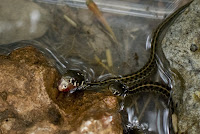 About six weeks ago my brother John bestowed upon us a rescued animal, a checkered garter snake (Thamnophis marcianus) my son Patrick promptly dubbed "Mr. Bubbles." John, in the course of his duties as a police officer, had plucked it from a terrified housewife's porch.
About six weeks ago my brother John bestowed upon us a rescued animal, a checkered garter snake (Thamnophis marcianus) my son Patrick promptly dubbed "Mr. Bubbles." John, in the course of his duties as a police officer, had plucked it from a terrified housewife's porch.The snake readily gobbled goldfish (the $ .12 kind, bred to be fed), was nice to look at and seemed to be doing just fine in a cage in the garage.
I've always been fascinated by snakes; their colorful patterns and glossy keratin-coated skins, their behaviors too, but mostly just the fact that they're here at all.
More than 2,700 species of snakes burst out of the Paleocene about 60 million years ago. Today they range across every continent except Antarctica. Some are marine reptiles, some live in trees, some live nearly their entire lives underground. None have external limbs and that's what I find so fascinating: they're basically bellies with mouths and some highly specialized senses, and they've been incredibly successful.
I fed our newest snake four medium-size goldfish right before we left on vacation last week, checked on her with a cursory glance the night we returned and woke up yesterday to a snake cage crawling with miniature replicas. Fourteen tiny Bubbles, to be exact.
When he dropped her off weeks ago, John mentioned the snake might be gravid, thought she felt heavy. After seeing no eggs for weeks and weeks, I kind of forgot about the possibility.
 Just like I forgot that garter snakes are viviparous, meaning they give live birth. Some of the newborns still have tiny threads of placenta attached to their belly buttons (I know, I know ... snakes with belly buttons; crazy, eh?).
Just like I forgot that garter snakes are viviparous, meaning they give live birth. Some of the newborns still have tiny threads of placenta attached to their belly buttons (I know, I know ... snakes with belly buttons; crazy, eh?).
What the heck do baby garter snakes eat? Smaller fish, says the man at PetSmart. So we load up on red comet minnows, some bigger fish for mom (Mrs. Bubbles, we now assume) and brought it all home. Bubbles devoured her five big goldfish, but the newborns didn't seem to know quite what to do.
Finally, the first one figured it out. Then another. Now only about six of the minnows are still swimming. In the wild, checkered garter snakes eat all sorts of things -- amphibians and fish, worms and mice -- whatever they can get to hold still long enough to swallow. They can grow to as long as 4 feet, but 24-inch specimens are much more common. That's about Bubbles' size.
In the wild, checkered garter snakes eat all sorts of things -- amphibians and fish, worms and mice -- whatever they can get to hold still long enough to swallow. They can grow to as long as 4 feet, but 24-inch specimens are much more common. That's about Bubbles' size.
Mrs. Bubbles is still pretty skittish around human hands, and likely will never be entirely tame. The babies, though, have no fear of humans and are perfectly comfortably climbing onto a hand reaching into their enclosure. Because they're relatively docile -- the captive-born animals, anyway -- and easy to keep, checkered garter snakes are common in the pet trade. A quick Internet search uncovered a handful for sale at $15-$30 apiece.
Because they're relatively docile -- the captive-born animals, anyway -- and easy to keep, checkered garter snakes are common in the pet trade. A quick Internet search uncovered a handful for sale at $15-$30 apiece.
Patrick's not sure what he wants to do with the little ones. He thinks maybe his friend Spencer will take one, if Spencer's mom says okay. Some will probably be set free to patrol our backyard and greenbelt once they're past Blue jay snack-size.
That's going to leave a lot of tiny Bubbles ... anyone want a snake?


